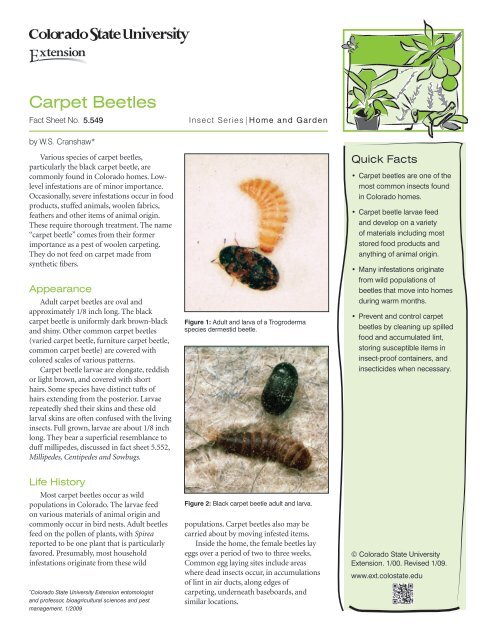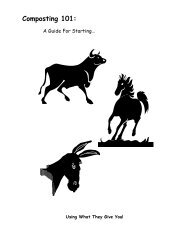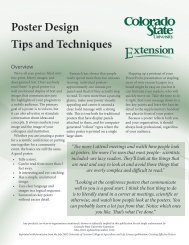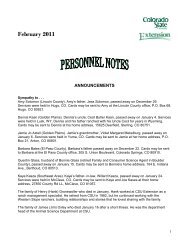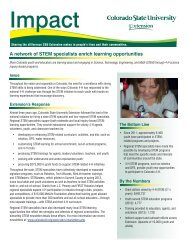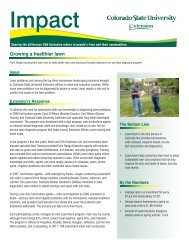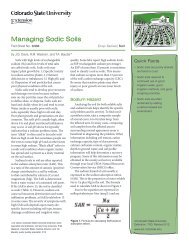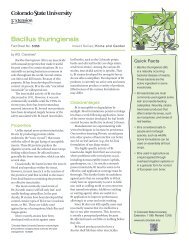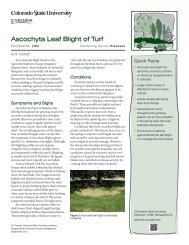Carpet Beetles - Colorado State University Extension
Carpet Beetles - Colorado State University Extension
Carpet Beetles - Colorado State University Extension
You also want an ePaper? Increase the reach of your titles
YUMPU automatically turns print PDFs into web optimized ePapers that Google loves.
<strong>Carpet</strong> <strong>Beetles</strong><br />
Fact Sheet No. 5.549<br />
Insect Series|Home and Garden<br />
by W.S. Cranshaw*<br />
Various species of carpet beetles,<br />
particularly the black carpet beetle, are<br />
commonly found in <strong>Colorado</strong> homes. Lowlevel<br />
infestations are of minor importance.<br />
Occasionally, severe infestations occur in food<br />
products, stuffed animals, woolen fabrics,<br />
feathers and other items of animal origin.<br />
These require thor ough treatment. The name<br />
“carpet beetle” comes from their former<br />
importance as a pest of woolen carpeting.<br />
They do not feed on carpet made from<br />
synthetic fibers.<br />
Appearance<br />
Adult carpet beetles are oval and<br />
approximately 1/8 inch long. The black<br />
carpet bee tle is uniformly dark brown-black<br />
and shiny. Other common carpet beetles<br />
(varied carpet beetle, furniture carpet beetle,<br />
common carpet beetle) are covered with<br />
colored scales of various patterns.<br />
<strong>Carpet</strong> beetle larvae are elongate, reddish<br />
or light brown, and covered with short<br />
hairs. Some species have distinct tufts of<br />
hairs extending from the posterior. Larvae<br />
repeatedly shed their skins and these old<br />
larval skins are often confused with the living<br />
insects. Full grown, larvae are about 1/8 inch<br />
long. They bear a superficial resemblance to<br />
duff millipedes, discussed in fact sheet 5.552,<br />
Millipedes, Centipedes and Sowbugs.<br />
Figure 1: Adult and larva of a Trogroderma<br />
species dermestid beetle.<br />
Quick Facts<br />
• <strong>Carpet</strong> beetles are one of the<br />
most common insects found<br />
in <strong>Colorado</strong> homes.<br />
• <strong>Carpet</strong> beetle larvae feed<br />
and develop on a variety<br />
of materials including most<br />
stored food products and<br />
anything of animal origin.<br />
• Many infestations originate<br />
from wild populations of<br />
beetles that move into homes<br />
during warm months.<br />
• Prevent and control carpet<br />
beetles by cleaning up spilled<br />
food and accumulated lint,<br />
stor ing susceptible items in<br />
insect-proof containers, and<br />
insecticides when neces sary.<br />
Life History<br />
Most carpet beetles occur as wild<br />
populations in <strong>Colorado</strong>. The larvae feed<br />
on various materials of animal origin and<br />
commonly occur in bird nests. Adult beetles<br />
feed on the pollen of plants, with Spirea<br />
reported to be one plant that is particularly<br />
favored. Presumably, most household<br />
infestations originate from these wild<br />
*<br />
<strong>Colorado</strong> <strong>State</strong> <strong>University</strong> <strong>Extension</strong> entomologist<br />
and professor, bioagricultural sciences and pest<br />
management. 1/2009<br />
Figure 2: Black carpet beetle adult and larva.<br />
populations. <strong>Carpet</strong> beetles also may be<br />
carried about by moving infested items.<br />
Inside the home, the female beetles lay<br />
eggs over a period of two to three weeks.<br />
Common egg laying sites include areas<br />
where dead insects occur, in accumulations<br />
of lint in air ducts, along edges of<br />
carpeting, underneath baseboards, and<br />
similar locations.<br />
© <strong>Colorado</strong> <strong>State</strong> <strong>University</strong><br />
<strong>Extension</strong>. 1/00. Revised 1/09.<br />
www.ext.colostate.edu
Figure 3: Furniture carpet beetle adult and larva.<br />
Figure 4: Old skins of varied carpet beetle<br />
larvae.<br />
The eggs hatch in 10 to 20 days and<br />
the newly emerged larvae search for food.<br />
Depending on the quality of the food<br />
source and the temperature, the larvae<br />
become full grown in two to 11 months.<br />
If a food source disappears during the<br />
insect’s develop ment, the larvae can survive<br />
for several weeks without food. Many<br />
carpet beetle larvae are quite mobile and<br />
can wander a consider able distance from<br />
a primary infesta tion. The most common<br />
carpet beetles in homes have a one-year life<br />
cycle. Adults and wandering larvae are most<br />
commonly encountered in late winter and<br />
early spring.<br />
Prevention and Control<br />
Several steps can help limit the<br />
occurrence of carpet beetle infestations.<br />
Regular cleaning of spilled food and<br />
accumulated lint eliminates primary<br />
breeding sites. Store food, woolens, furs<br />
and other susceptible items in insect-proof<br />
containers to prevent access by the larvae.<br />
During warm months, the adult beetles can<br />
be largely excluded by using screens and<br />
sealing other openings.<br />
When a carpet beetle infestation is<br />
suspected, closely examine preserved<br />
animals or hides for live larvae or cast<br />
skins, as carpet beetles frequently infest<br />
these objects. Check all areas where<br />
lint, especially dog or cat hair, tends to<br />
accumulate: areas under carpets and<br />
along carpet edges; under seldom-moved<br />
furniture; in floor cracks, registers and<br />
ducts; and in folds of upholstered furniture.<br />
Check stored woolen clothing, flannel<br />
and woolen yarn in attics, basements<br />
and closets. Look through food products<br />
stored for long periods without use. Other<br />
possible breeding sites are old animal or<br />
bird nests that may be in the house, and<br />
collections of dead insects around windows.<br />
When you find the source of the<br />
problem, remove and destroy the infested<br />
material if possible. Objects which cannot<br />
be discarded should be treated to kill eggs<br />
and larvae. Store small items in a freezer for<br />
48 hours or heat-treat them at temperatures<br />
above 120 degrees F for several hours.<br />
Dry-clean infested clothing. Put infested<br />
nonfood materials in a plastic bag with a<br />
“pest-strip” for several weeks. Elimination<br />
of carpet beetles from large objects, such<br />
as furniture, may require the services of a<br />
professional pest control operator.<br />
Figure 5: Larvae of carpet beetles.<br />
Thoroughly clean the house when<br />
carpet beetles are detected. Pay particular<br />
attention to areas where lint accumulates<br />
and move furniture occasionally to expose<br />
possible hidden breeding areas.<br />
Chemical Controls<br />
It is sometimes useful to treat infested<br />
areas with insecticides to eliminate residual<br />
populations of carpet beetles. In nonfood<br />
areas household formulation of various<br />
pyrethroid insecticides can be used.<br />
Numerous products allow such use and<br />
contain as the active ingredient permethrin,<br />
bifenthrin, deltamethrin, tralomethrin and<br />
related compounds. Use according to label<br />
directions and pay particular attention<br />
to treating baseboards, corners, edges of<br />
carpeting and other areas where lint and<br />
other debris accumulates that is fed on by<br />
carpet beetles.<br />
Insecticides should only be used<br />
in addition to a thorough cleanout of<br />
potential breeding sites. Most household<br />
insecticides will provide some residual<br />
effect for control but carpet beetles may<br />
reinfest from outdoor sources during the<br />
warm season.<br />
<strong>Colorado</strong> <strong>State</strong> <strong>University</strong>, U.S. Department of<br />
Agriculture and <strong>Colorado</strong> counties cooperating.<br />
CSU <strong>Extension</strong> programs are available to all without<br />
discrimination. No endorsement of products mentioned<br />
is intended nor is criticism implied of products not<br />
mentioned.


